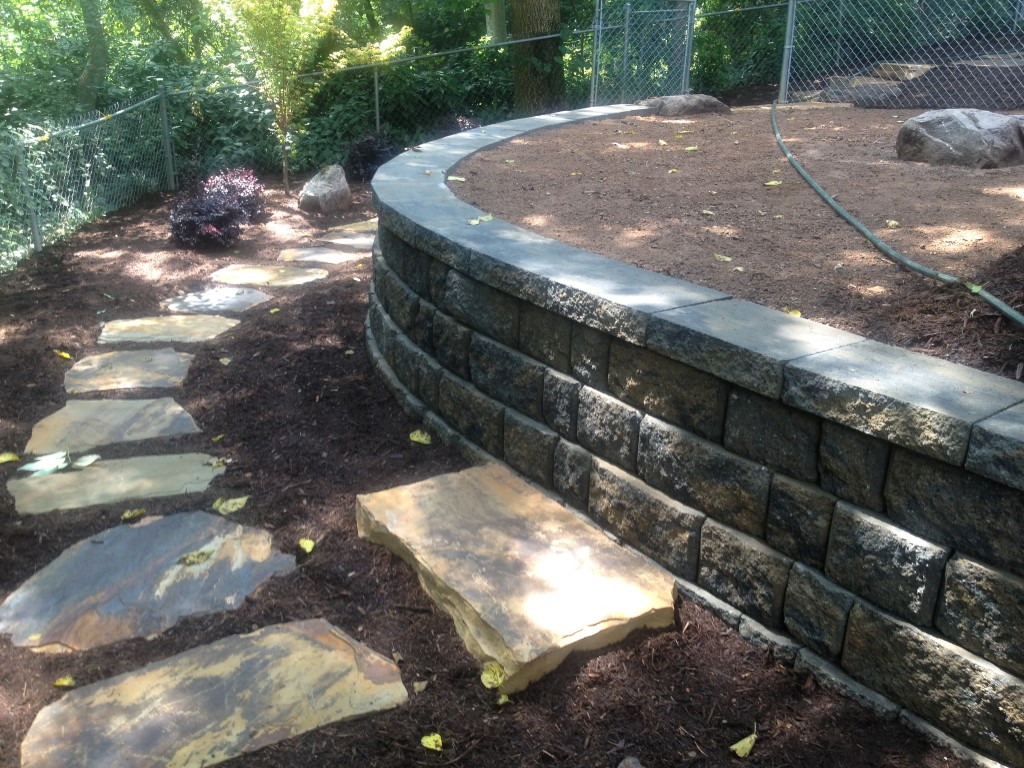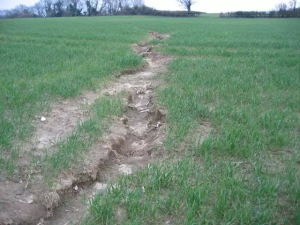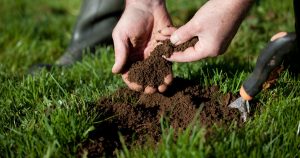A well-crafted retaining wall around your gardens and flower beds can really make your home and landscapes shine! Retaining walls not only help prevent soil erosion, but also add dimension and structure to the space around your home. They really upgrade the visual appeal of your home as a whole. I could go on and on about how beautiful and great retaining walls are, but if you click on this post, then you probably already have an idea of that yourself, so let’s focus on the building aspect. Building your own retaining wall can be quite the daunting task. In fact, we’ll admit that depending on the size and purpose of the retaining wall, they should really only be installed by someone with experience and expertise in this field. But! That being said, we can definitely walk you through the main 4 steps that it takes to building a simple retaining wall around your flower beds and gardens.
Step 1: Planning and Preparation
Before starting any construction, careful planning is essential. In order to properly plan for this project, here are some basic steps to follow:
Check Local Regulations
Ensure that you’re aware of any zoning laws or building codes in your area related to constructing retaining walls. These regulations may dictate the maximum height and materials allowed, so it’s crucial to comply with those.
Choose the location
Now, you need to select the ideal location for your retaining wall. Consider factors such as the slope of the terrain, drainage patterns when it rains, and position of nearby structures or plants. A location that receives ample sunlight and complements your garden’s layout is ideal.
Decide on the wall design
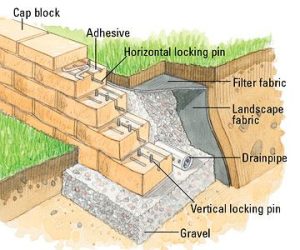
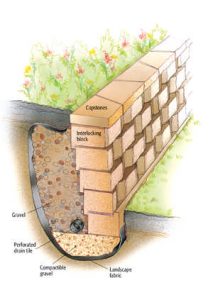 Once you’ve chosen a location for your wall, now you can choose the style and materials. Materials like natural stone, bricks, concrete blocks, or treated wood can all be used. Some are more expensive but will last longer and visa-versa. It simply depends on your budget, tastes, and long-term plan with this wall. You’ll simply want to make sure that the design harmonizes with your home and gardens.
Once you’ve chosen a location for your wall, now you can choose the style and materials. Materials like natural stone, bricks, concrete blocks, or treated wood can all be used. Some are more expensive but will last longer and visa-versa. It simply depends on your budget, tastes, and long-term plan with this wall. You’ll simply want to make sure that the design harmonizes with your home and gardens.
Gather materials and tools
Now that you have chosen the location and the design of the wall, you can now start collecting all the necessary materials and tools before starting the construction. Common tools include a shovel, take measure, level, rubber mallet, saws, wheelbarrow, and more. Also, make sure you have any and all safety equipment such as proper gloves and safety glasses.
Step 2: excavation and foundation
Now that the wall has been properly designed and planned for, and you have all the necessary tools and equipment that you are needing for your particular design, you can now begin with building the foundation of your wall.
Mark the area
Before you begin any digging, Outline the path of your retaining wall using a biodegradable spray paint or stakes and string. This will give you a clear guide while excavating. This is a step that is often overlooked by individuals and companies, which can result in issues down the road.
Excavate the trench
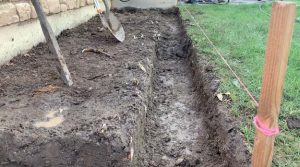 Once you feel you are ready, start digging a trench where your retaining will be located. The depth of the trench should be determined by the height of the wall you plan to build, plus an additional 6 inches for a stable foundation. Ensure that the trench’s width is enough to accommodate the first layer of the chosen material.
Once you feel you are ready, start digging a trench where your retaining will be located. The depth of the trench should be determined by the height of the wall you plan to build, plus an additional 6 inches for a stable foundation. Ensure that the trench’s width is enough to accommodate the first layer of the chosen material.
Compact the soil
Use a hand tamper or plate compactor to compact the soil at the bottom of the trench. This step is crucial so as to prevent uneven settling of the retaining wall as time passes.
Lay the gravel base
Once you are comfortable with the base and feel that it is as level as you can get it, it is now time to lay down the gravel. You’ll want about 4 inches of gravel in the trench, and once it is laid, you’ll want to compact that as well. This will aid in drainage and prevent water buildup behind the wall.
Step 3: Building the Retaining Wall
Now that you’ve laid out your gravel base, make sure that everything is level and at the right height before you begin installing the wall. Like the saying goes, “measure twice and cut once”, you’ll want to ensure that you are building your wall on a sure foundation.
Lay the first course
Begin laying the first course of your chosen material. For stone or bricks, ensure that the largest, flattest pieces are used as the base. Check each stone or brick with a level to ensure they’re even and levelled. It’s tons easier to fix it while it’s small instead of being forced to fix it once it’s big.
Check for level and alignment
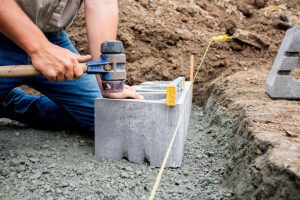 As you are adding each stone or brick, use a level and a rubber mallet to ensure they are level and aligned with the string guides that you installed earlier. This is most important on the first level.
As you are adding each stone or brick, use a level and a rubber mallet to ensure they are level and aligned with the string guides that you installed earlier. This is most important on the first level.
Use adhesive or mortar (if applicable)
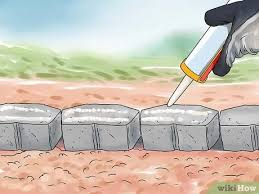 Depending on the material you’re using, you may need to apply adhesive or mortar between the stones or bricks to hold them in place securely.
Depending on the material you’re using, you may need to apply adhesive or mortar between the stones or bricks to hold them in place securely.
Fill the gaps
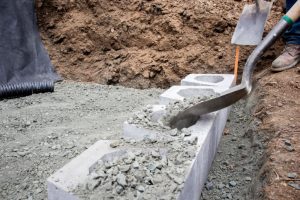 As you go along, make sure to fill in any gaps between the stones or bricks with crushed stone or gravel. This will aid in drainage and provide additional stability.
As you go along, make sure to fill in any gaps between the stones or bricks with crushed stone or gravel. This will aid in drainage and provide additional stability.
Build subsequent courses
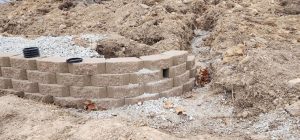 Continue building subsequent courses of stones or bricks, staggering the joints to create a sturdy and visually appealing wall. Check for level and alignment after each course.
Continue building subsequent courses of stones or bricks, staggering the joints to create a sturdy and visually appealing wall. Check for level and alignment after each course.
Add Drainage pipes (if needed)
For taller retaining walls, consider adding perforated drainage pipes behind the wall to prevent water buildup. Connect the pipes to a suitable drainage system.
Step 4: finishing touches
The bulk of the work is done! Congratulations on a job well done! But wait, the job isn’t completely done yet. There are still some finishing touches that need to be taken care of, and you never want to skip the finishing touches.
Cap the retaining wall
For added stability and a polished look, use capstones or a flat, durable material to create a top layer for your retaining wall.
Backfill
Make sure that you initially backfill your retaining wall with clean gravel to allow for water drainage. It is often even a good idea to install some landscape fabric overtop of this gravel to make sure that dirt, soil, and mud don’t fill in the cracks and clog the drainage system here. Once you’ve done that, then you can fill in with soil overtop.
Landscaping
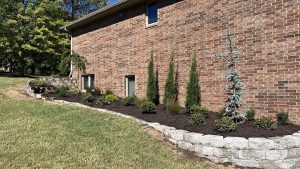 After the retaining wall is complete and backfilled, now you can either plant your grass seed or your landscape plants such as flowers, shrubs, and trees. Use appropriate spacing to ensure a healthy and vibrant landscape or lawn for years to come.
After the retaining wall is complete and backfilled, now you can either plant your grass seed or your landscape plants such as flowers, shrubs, and trees. Use appropriate spacing to ensure a healthy and vibrant landscape or lawn for years to come.
Conclusion
 It’s complete! As you probably gathered from reading this article, building a retaining wall can be time consuming and expensive, but also rewarding. A beautifully built landscape will enhance both the aesthetics and functionality of your outdoor space. With careful planning, the right materials, and proper constuction techniques, you can create a visually stunning and long-lasting addition to your garden that will be admired for years to come. Remember to follow safety guidelines, take your time with each step, and don’t hesitate to seek professional advice if needed. By implememting regular maintenance practices, your landscape retaining wall will stand the test of time, providing a beautiful and functional enhancement to your garden for generations.
It’s complete! As you probably gathered from reading this article, building a retaining wall can be time consuming and expensive, but also rewarding. A beautifully built landscape will enhance both the aesthetics and functionality of your outdoor space. With careful planning, the right materials, and proper constuction techniques, you can create a visually stunning and long-lasting addition to your garden that will be admired for years to come. Remember to follow safety guidelines, take your time with each step, and don’t hesitate to seek professional advice if needed. By implememting regular maintenance practices, your landscape retaining wall will stand the test of time, providing a beautiful and functional enhancement to your garden for generations.
Happy landscaping out there!
Who we are
Thank you for reading another of our blogs. We are a lawn and landscaping company based in Mountain Grove, Missouri (MO). We will build retaining walls as far out as West Plains, Houston, Ava, and all in between. We love this work, and love to learn how we can always improve the services that we provide our customers. If you are in need of any lawn or landscaping services and you live in or around Ava, Mansfield, Mountain Grove, Cabool, Houston, Willow Springs, Mountain View, or West Plains Missouri, then please reach out to us and we will do our best to help you. Thank you and have a blessed day!



